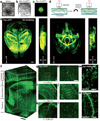Structural and molecular interrogation of intact biological systems
- PMID: 23575631
- PMCID: PMC4092167
- DOI: 10.1038/nature12107
Structural and molecular interrogation of intact biological systems
Abstract
Obtaining high-resolution information from a complex system, while maintaining the global perspective needed to understand system function, represents a key challenge in biology. Here we address this challenge with a method (termed CLARITY) for the transformation of intact tissue into a nanoporous hydrogel-hybridized form (crosslinked to a three-dimensional network of hydrophilic polymers) that is fully assembled but optically transparent and macromolecule-permeable. Using mouse brains, we show intact-tissue imaging of long-range projections, local circuit wiring, cellular relationships, subcellular structures, protein complexes, nucleic acids and neurotransmitters. CLARITY also enables intact-tissue in situ hybridization, immunohistochemistry with multiple rounds of staining and de-staining in non-sectioned tissue, and antibody labelling throughout the intact adult mouse brain. Finally, we show that CLARITY enables fine structural analysis of clinical samples, including non-sectioned human tissue from a neuropsychiatric-disease setting, establishing a path for the transmutation of human tissue into a stable, intact and accessible form suitable for probing structural and molecular underpinnings of physiological function and disease.
Figures





Comment in
-
CLARITY--a clearer view of the brain.Neurosurgery. 2013 Aug;73(2):N16. doi: 10.1227/01.neu.0000432622.44397.74. Neurosurgery. 2013. PMID: 23867270 No abstract available.
-
CLARITY or the invisible brain.Mov Disord. 2013 Oct;28(12):1639. doi: 10.1002/mds.25619. Epub 2013 Sep 16. Mov Disord. 2013. PMID: 24105932 No abstract available.
References
-
- Denk W, Strickler JH, Webb WW. Two-photon laser scanning fluorescence microscopy. Science. 1990;248:73–76. - PubMed
-
- Carmeliet P, Tessier-Lavigne M. Common mechanisms of nerve and blood vessel wiring. Nature. 2005;436:193–200. - PubMed
-
- Helmchen F, Denk W. Deep tissue two-photon microscopy. Nature Methods. 2005;2:932–940. - PubMed

